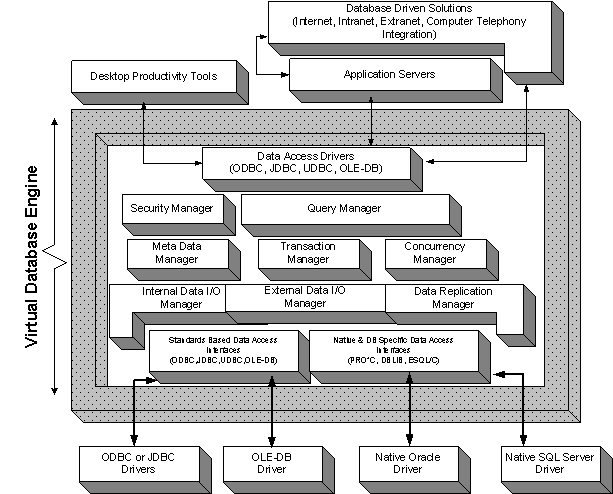Chapter 8. Virtual Database Engine
Abstract
This chapter covers Remote Table Attachment, Usage of Remote Tables from ODBC, JDBC, ADO.NET, SQLX, XPath/XQuery, Linked Data Views.
Table of Contents
- 8.1. Virtual Database (VDB) Engine
-
- 8.1.1. The Need for VDB Engines
- 8.1.2. First Generation Virtual Database Products
- 8.1.3. VDB Implementation Issues
- 8.1.4. VDB Engine Components
- 8.2. Using Microsoft Entity Frameworks to Access Oracle Schema Objects with Virtuoso
- 8.3. Using Microsoft Entity Frameworks to Access Progress Schema Objects with Virtuoso
-
- 8.3.1. Install and configure OpenLink ODBC Driver for Progress (SQL-92)
- 8.3.2. Install and configure OpenLink Virtuoso Universal Server
- 8.3.3. Linking Progress tables into Virtuoso
- 8.3.4. Creating EDM in Visual Studio 2008
- 8.3.5. Manually creating EDM Associations (FKs) for the Progress isports database
- 8.3.6. Using EDM to create Entity Framework based applications
- 8.4. Using Microsoft Entity Frameworks to Access Ingres Schema Objects with Virtuoso
-
- 8.4.1. Install and configure OpenLink ODBC Driver for Ingres
- 8.4.2. Install and configure OpenLink Virtuoso Universal Server
- 8.4.3. Linking Ingres tables into OpenLink Virtuoso
- 8.4.4. Creating EDM in Visual Studio 2008
- 8.4.5. Manually creating EDM Associations (FKs) for the Ingres Tutorial database
- 8.4.6. Using EDM to create Entity Framework based applications
- 8.5. Using Microsoft Entity Frameworks to Access Informix Schema Objects with Virtuoso
- 8.6. Using Microsoft Entity Frameworks to Access DB2 Schema Objects with Virtuoso
- 8.7. Using Microsoft Entity Frameworks to Access Sybase Schema Objects with Virtuoso
-
- 8.7.1. Install and configure OpenLink ODBC Driver for Sybase
- 8.7.2. Install and configure OpenLink Virtuoso Universal Server
- 8.7.3. Linking Sybase tables into OpenLink Virtuoso
- 8.7.4. Creating EDM in Visual Studio 2008
- 8.7.5. Manually creating EDM Associations (FKs) for the Sybase pubs2 database
- 8.7.6. Using EDM to create Entity Framework based applications
- 8.8. Using Microsoft Entity Frameworks to Access MySQL Schema Objects with Virtuoso
- 8.9. Using Microsoft Entity Frameworks to Access PostgreSQL Schema Objects with Virtuoso
- 8.10. Using Microsoft Entity Frameworks to Access ODBC to JDBC Bridge Schema Objects with Virtuoso
-
- 8.10.1. Install and configure OpenLink ODBC Driver for ODBC to JDBC Bridge
- 8.10.2. Install and configure OpenLink Virtuoso Universal Server
- 8.10.3. Linking ODBC to JDBC Bridge tables into OpenLink Virtuoso
- 8.10.4. Creating EDM in Visual Studio 2008
- 8.10.5. Using EDM to create Entity Framework based applications
- 8.11. Using Microsoft Entity Frameworks to Access ODBC to ODBC Bridge Schema Objects with Virtuoso
- 8.12. Using Microsoft Entity Frameworks to Access Firebird Schema Objects with Virtuoso
- 8.13. Using Microsoft Entity Frameworks to Access Microsoft SQL Server Schema Objects with Virtuoso
-
- 8.13.1. Install and configure OpenLink ODBC Driver for Microsoft SQL Server
- 8.13.2. Install and configure OpenLink Virtuoso Universal Server
- 8.13.3. Linking Microsoft SQL Server tables into OpenLink Virtuoso
- 8.13.4. Creating EDM in Visual Studio 2008
- 8.13.5. Using EDM to create Entity Framework based applications
- 8.14. Parallel Operations and Bulk Data Transfer with Remote Tables
8.1. Virtual Database (VDB) Engine
8.1.1. The Need for VDB Engines
Situation Analysis
As computer hardware, network protocols, database engines, applications, application servers, and desktop productivity tools, proliferate the enterprise, integration of disparate applications from disparate vendors is becoming an all too common problem.
Add the emergence of standards based Distributed Computing galvanized by the Internet infrastructure and associated Internet protocols to this picture, and the need for Integration is even higher.
Increasing the industry at large is looking to a new technology deliverable known as Universal Data Access Middleware to address these systems integration pains.
"With Universal Data Access (UDA), customers receive all of the benefits of a high-level and consistent Application Programming Interface (API) that abstracts all the database complexities while providing a capability that can be specified, controlled, and managed on its own to optimize the near universal need of programs for data access".
Source IDC, 1998 Middleware Markets & Trends
At OpenLink Software, it is our opinion that a new genre of UDA middleware called the "Virtual Database", is set to emerge as the dominant UDA middleware solution for addressing the integration challenges as they exist today, and tomorrow. This new UDA middleware format plays the role of a Universal Data Access manager, fusing traditional database functionality and traditional data access middleware functionality into a single independent packaged software solution.
Virtual Database Engines Defined
A Virtual Database (VDB) Engine is a UDA middleware format that transparently brings local and or remote heterogeneous databases together using logical database references called Data Source Names (DSN's). A VDB Engine exposes Metadata and Data held within these heterogeneous DSN's to clients applications and services homogeneously.
VDB Engines presume the existence of a number of Database Engines and Data Access Drivers provided by a variety of database vendors within an organization. VDB Engines provide transparent access to these heterogeneous databases via DSN's associated with the relevant data access drivers without exposing end-users or developers to the intricacies of heterogeneous data access.
Data Source Names (DSN's)
A Data Source Name is a logical reference that exposes database to standards compliant or native data access drivers. DSN's provide a flexible naming and binding service for database driven applications developers and end-users alike. Applications no longer need to be inextricably linked to specific database names or specific database engines.
Figure 8.1. Distributed Computing Infrastructure Incorporating A Virtual Database Engine
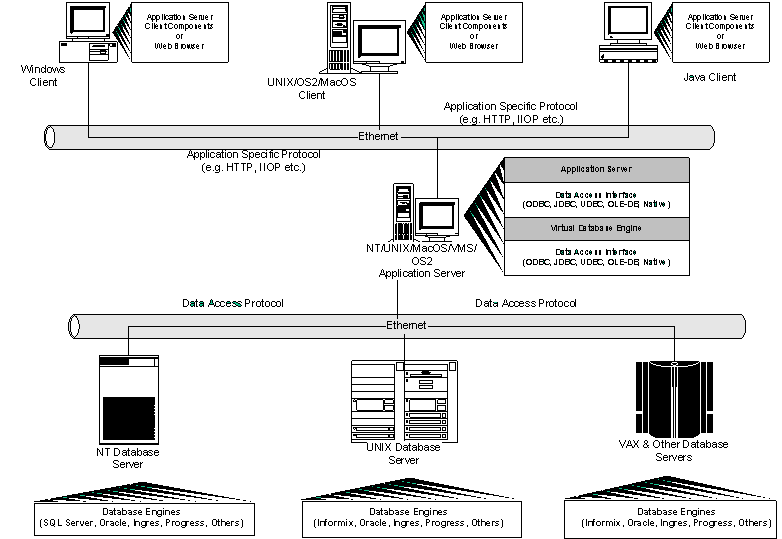
8.1.2. First Generation Virtual Database Products
Although the strict VDB definition may be new, there are a number of products that have been around for a while that attempt to address VDB issues. The list of such products includes The Microsoft JET Engine, Borland Database Engine (BDE), and IBM DataJoiner.
Microsoft JET
The Microsoft JET Engine lies at the heart of Microsoft Access, it is the piece of technology that allows you to link external and typically remote database tables into your local Access space via ODBC Data Sources. Once this link process has been completed, Access allows you to build Queries, Reports, Forms etc. using these external database tables as though they were Local Access tables. JET can also link to external tables hosted within desktop database engines via native interfaces.
The Microsoft JET Engine services are exposed via Microsoft provided data access interfaces such as: DAO, ADO, and OLE-DB. These interfaces are integral parts of most Microsoft applications, thereby exposing the benefits of the JET VDB transparently.
Borland Database Engine
The Borland Database Engine (BDE) from Inprise like the Microsoft JET Engine also facilitates external table linkage via ODBC Data Sources. The BDE also lets you link to external database tables via native database interfaces and there is no restriction to desktop database engines when you adopt this approach.
Although the BDE has a published set of APIs, it is predominantly used by Inprise applications in very much the same way JET is used by Microsoft applications.
IBM DataJoiner
DataJoiner from IBM provides the ability access heterogeneous data sources via IBM DB/2 Client Application Enablers. It does support ODBC and JDBC as client interfaces and makes use of Native or ODBC based data access for external Data I/O.
8.1.3. VDB Implementation Issues
The essential components that affect the implementation of VDB Engines are, High-Level Data Access Interfaces, Low-Level Data Access Interfaces and Traditional Database Functionality.
High-Level Data Access Interfaces
A VDB Engine's capabilities are exposed via High Level Data Access interfaces. For the purpose of this document, a high level data access interface is an interface utilized predominantly by applications, as opposed to middleware developers for achieving application database independence. A high level data access interface sits atop Low-Level data access interfaces, providing an abstraction layer that serves to simplifying the process of database independent application development.
A number of High Level Data Access standards exist today, the more prevalent being:
| Data Access Objects (DAO) |
| Remote Data Objects (RDO) |
| ActiveX Data Objects (ADO) |
| OLE-DB |
| JavaBlend |
| InfoBus |
It is important to note that low-level Data access interfaces such as ODBC, UDBC, JDBC and OLE-DB transparently serve the high-level interfaces mentioned in the section above. Thus, in most cases VDB vendors will treat ODBC, UDBC, JDBC, and OLE-DB as high-level interfaces by providing VDB data access drivers conforming to these standards as part of the VDB deliverable.
Low-Level Data Access Interfaces
A VDB Engine's data I/O occurs via low-level data access interfaces to underlying database engines or data sources. In recent times the Open Database Connectivity (ODBC ) API and the X/Open SQL Call Level Interface (CLI) have emerged as the dominant industry wide Low-Level Data Access Standards. OLE-DB from Microsoft is also emerging as a new low-level data access standard for relational and non-relational data in the Microsoft Component Object Model (COM) world. While JDBC is emerging like wise as the low-level data access standard for the burgeoning Java world.
A VDB may also be a Native Database Interface Client, making use of database engine vendor provided data access interfaces. Native interfaces are based upon Embedded SQL, an older format Low-Level data access interface that preceded the X/Open SQL CLI. It is important to note that ODBC from Microsoft, JDBC from JavaSoft, and UDBC from OpenLink Software are all derived from the X/Open SQL CLI.
Traditional Database Functionality
The degree to which a VDB implements a traditional database engine's functionality has a direct bearing on the intrinsic value of a VDB engine. Traditional database functionality is extensive, but for the purposes of this document, a core set of functionality common to all commercial database engines has been assembled. The functionality list includes:
Query Language Support. standard syntax for interrogating, manipulating, describing, and securing data contained within a database. Examples include the Structured Query Language (SQL) for relational databases and the Object Query Language (OQL) for Object and Object-Relational Databases.
Query Processor. the mechanism used by a database engine to convert Query Language Statements into actual data retrieval instructions. In addition, this database component is responsible for ensuring Query Language syntax conformance, Query Execution Plan Assembly and Query Fulfillment.
Standard Data Types Support. data contained within a database must be describable using standard data types e.g. Character, Number, Date, etc.
VIEW Support. pre constructed query statements stored within a database, for the purpose of query simplification, or content and structural security.
Stored Procedure Support. Stored Procedures facilitate the embedding of application programming logic within a database. Their pre-compiled nature enhances data access performance by reducing message hops between database servers and database clients.
Scrollable Cursor Support. the process by which the result of a database query (known as a result-set) is traversed. Traversal occurs in either direction, backwards or forwards, using result-set chunks (known as row-sets). Resultset scrolling occurs when database engines exchange data with database clients.
Concurrency Control. the process through which a database engine supports multiple sessions running concurrently, across multiple database users and database client applications without compromising underlying data integrity or introducing quantum increases in application response times.
Transaction Support. ensures that database instructions can be grouped into logical units of execution that are Atomic, Consistent, Isolated from the effect of other units of execution affecting the same underlying data, and Durable.
Transaction Isolation. describes the ability of a database engine to provide transaction process partitioning options called Isolation Levels, that offer different ways of managing the effects of multiple and concurrent transactions affecting the same underlying data.
Distributed Transaction Support. describes the ability to preserve transaction atomicity, consistency, integrity, and durability across database servers hosted on the same or different database server machines within a networked environment. This involves supporting transaction Commits and Rollbacks using a 2-phase commit protocol.
User Definable Type Support. this is how a database engine allows end-users extend its base functionality. This is achieved by providing interfaces that allow end-users create new ways in which a database engine's data is described and manipulated.
Federated Database Support. data access and manipulation across database servers resident on the same machine.
Distributed Database Support. data access, and manipulation across database servers resident on the different machines within a networked environment.
Security. the process by which data, and data transmission is protected using a combination of database and operating system privileges, roles and roles hierarchies. It also includes the ability of a database engine to protect data transmitted to its clients using data encryption.
8.1.4. VDB Engine Components
The prior section outlined the critical implementation issues that affect the development and implementation of VDB Engines. These issues form the basis around which a component based framework for depicting VDB architectures has been derived.
The components that comprise a VDB Engine framework are as follows:
Data Access Drivers
The VDB component that forms the entry point to the VDB Engine's services, these drivers may or may not conform to industry standards. Applications and Services that sit atop a VDB Engine must have their data access layers written to the same Application Programming Interfaces (APIs) implemented by the Data Access Drivers provided by a VDB engine.
Security Manager
The VDB component that is responsible for protecting data and data transmission (using encryption) within the VDB Engine's domain. It is also responsible for managing Application, User, Group, Role and Domain privileges as they relate to the creation, manipulation and destruction of VDB data and metadata.
Query Manager
The VDB component that handles queries presented to it by the VDB Engine's data access drivers. It provides query syntax checking, query execution plan compilation, and query fulfillment services. A query processor is built in conformance to one or more query language specifications, the most notable being the Structured Query Language (SQL) for relational database engines, and the Object Query Language (OQL) for Object-Relational and Object Database engines.
Meta Data Manager
The VDB component that provides the Query Processor with information about the data entities from which the Query Processor's execution plan is derived. Metadata managers are also the components responsible for linking external data sources into the VDB domain and directing the Query Processor to the appropriate Data I/O manager.
Transaction Manager
The Transaction Manager component ensures that transactions are Atomic (clearly distinguishable units), Consistent (thereby preserving integrity of data), Isolated from the effect of other transactions, and Durable (such that the effects of committed transactions survive failure). The Transaction Manager ensures VDB Engines are capable of supporting Online Transaction Processing (OLTP) and Distributed Transaction oriented applications and services. Transaction Managers may be standards based implementing X/Open's XA Resource Manager Specifications. Distributed transaction support is implemented by using a two-phase commit protocol.
Concurrency Manager
The VDB component that ensures client applications and services are capable of opening multiple concurrent sessions that execute data INSERTS, UPDATES and DELETIONS, without implicitly reducing application response times or compromising data integrity. Concurrency control is delivered in one of two formats, Optimistic or Pessimistic depending on the response times desired by VDB client applications or services.
Local Data I/O Manager
VDB Engine's that provide local data storage uses this component for reading and writing data to disk. This is how a VDB provides traditional database engine data storage services.
External Data I/O Manager
VDB component that handles data reads and writes to external data sources. The External Data I/O Manager be implemented using standard data access interfaces such as ODBC, JDBC, UDBC, OLE-DB or Native data source interfaces.
Replication Manager
Component that manages data migration and synchronization across two or more VDB servers within a distributed computing environment. This component acts as a data coordinator between the activities of Local Data I/O and External Data I/O Managers across VDB servers. The Replication Manager enables a VDB Engine offer automated bi-directional data, and metadata transformation services across heterogeneous data sources without end-user or developer intervention.
Figure 8.2. Virtual Database Engine Architecture & Components
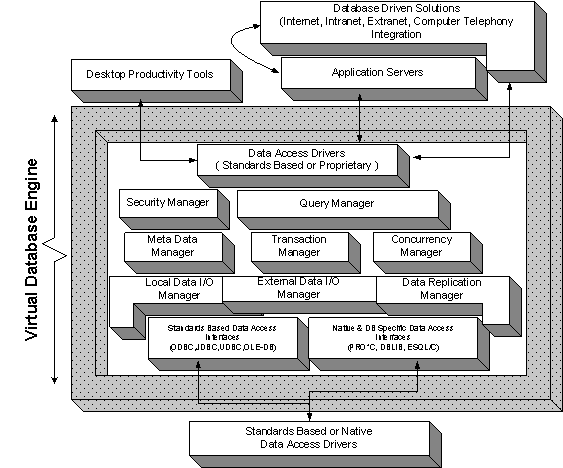
VDB Implementation Approaches
There are no golden VDB implementation specifications, but the implementation of a VDB has a direct impact the degree to which you realize desired value from the VDB concept as a whole.
The VDB value proposition is simply stated as follows:
"To provide transparent access to heterogeneous data sources, independent of host operating system and underlying database engines ".
VDB implementations can be categorized as follows:
Table 8.1. VDB Implementation Categories
| VDB Data Access Interface | VDB External Data I/O | Traditional Database Functionality | |
|---|---|---|---|
| Type 1 | Native | Native | Partial |
| Type 2 | Native | Native | Full |
| Type 3 | Native | Standards Based | Partial |
| Type 4 | Native | Standards Based | Full |
| Type 5 | Standards Based | Native | Partial |
| Type 6 | Standards Based | Native | Full |
| Type 7 | Standards Based | Standards Based | Partial |
| Type 8 | Standards Based | Standards Based | Full |
| Type 9 | Standards Based | Standards Based or Native | Partial |
| Type 10 | Standards Based | Standards Based or Native | Full |
The sections that follow provide illustrations of the different VDB formats, depicting the components that provide the basis for the categorization used in the table above.
Type 1 VDB Engine
This category of VDB exposes its services to clients via Native and Proprietary high-level data access interfaces. Data I/O is achieved via native, proprietary, and data source specific low-level data access interfaces. This category of VDB does not possess a complete set of traditional database engine components.
Figure 8.3. Type 1 VDB Engine Architecture
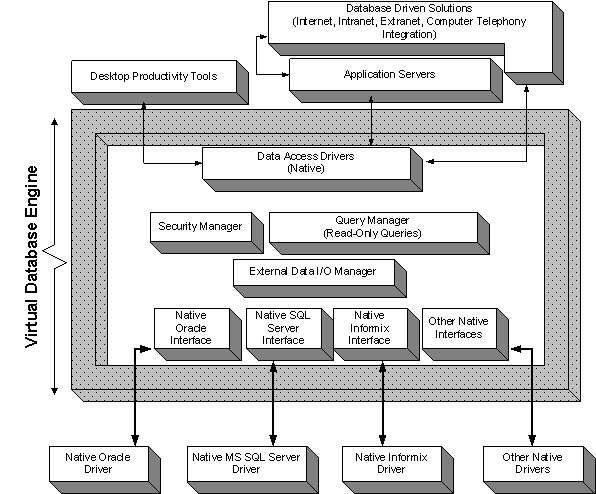
Type 2 VDB Engine
This category of VDB exposes its services to clients via Native and Proprietary high-level data access interfaces. External data I/O is achieved via native, proprietary, and data source specific low-level data access interfaces. This category of VDB possesses a complete set of traditional database engine components.
Figure 8.4. Type 2 VDB Engine Architecture
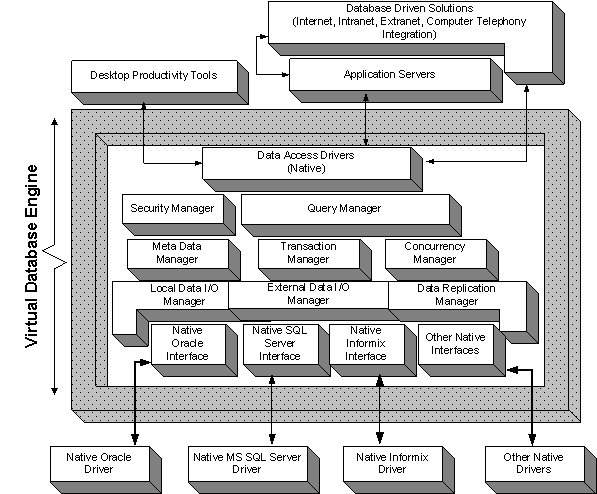
Type 3 VDB Engine
This category of VDB exposes its services to clients via Native and Proprietary high-level data access interfaces. Data I/O is achieved via Open, Standards based, and Database Independent low-level data access interfaces. This category of VDB does not possess a complete set of traditional database engine components.
Figure 8.5. Type 3 VDB Engine Architecture
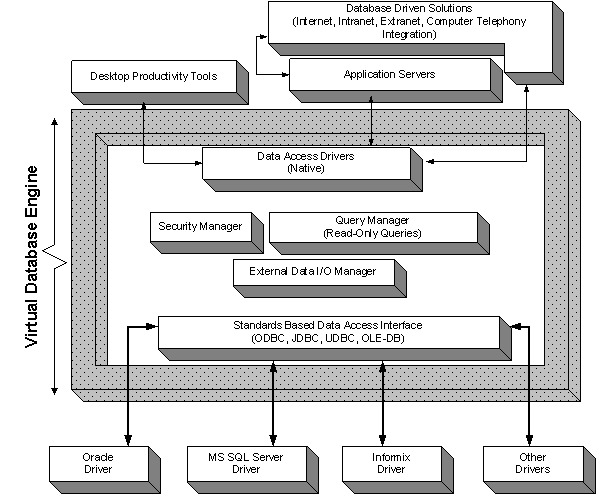
Type 4 VDB Engine
This category of VDB exposes its services to clients via Native and Proprietary high-level data access interfaces. External data I/O is achieved via Open, Standards based, and Database Independent low-level data access interfaces. This category of VDB possesses a complete set of traditional database engine components.
Figure 8.6. Type 4 VDB Architecture
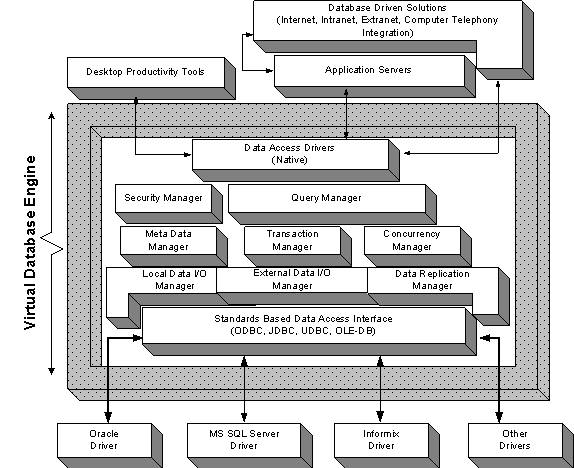
Type 5 VDB Engine
This category of VDB exposes its services to clients via open and standards based high-level data access Interfaces. Data I/O is achieved via native, proprietary, and data source specific low-level interfaces. This category of VDB does not possess a complete set of traditional database engine components.
Figure 8.7. Type 5 VDB Engine Architecture
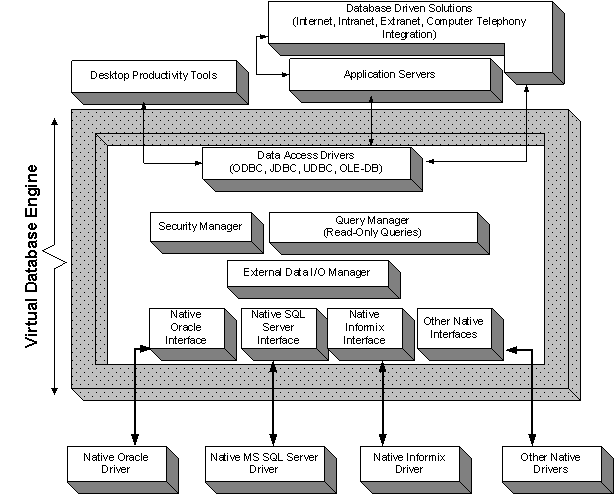
Type 6 VDB Engine
This category of VDB exposes its services to clients via open, standards based, high and low-level Interfaces. External data I/O is achieved via native, proprietary, and data source specific low-level interfaces. This category of VDB possesses a complete set of traditional database engine components.
Figure 8.8. Type 6 - VDB Engine Architecture

Type 7 VDB Engine
This category of VDB exposes its services via open, standards based high-level data access interfaces. Data I/O is achieved via Open, Standards based, and Database Independent low-level data access interfaces. This category of VDB does not possess a complete set of traditional database engine components.
Figure 8.9. Type 7 VDB Engine Architecture
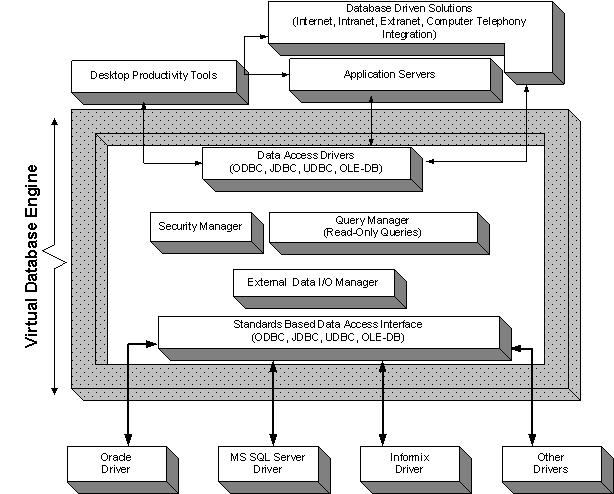
Type 8 VDB Engine
This category of VDB exposes its services via open, standards based, high and low-level interfaces. External data I/O is achieved via Open, Standards based, and Database Independent low-level data access interfaces. This category of VDB does possess a complete set of traditional database engine components.
Figure 8.10. Type 8 VDB Engine Architecture
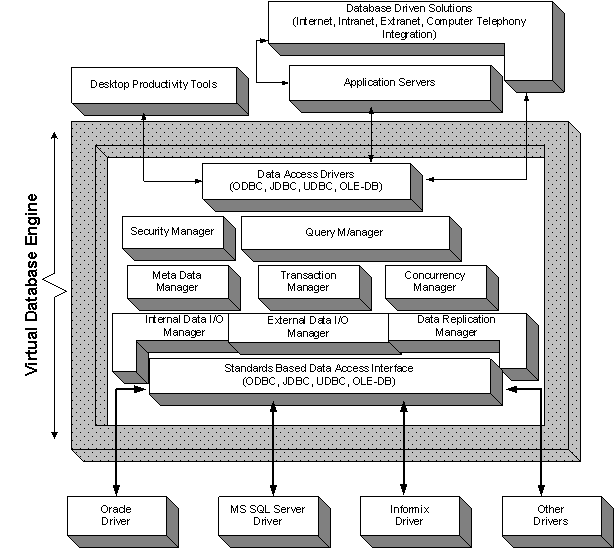
Type 9 VDB Engine
This category of VDB exposes its services via Open, Standards based, high-level data access interfaces. Data I/O is achieved by using either Open, Standards based, and Database Independent low-level data access interfaces or Native, Proprietary, and Database Specific low-level data access interfaces. This category of VDB does not possess a complete set of traditional database engine components.
Figure 8.11. Type 9 VDB Architecture
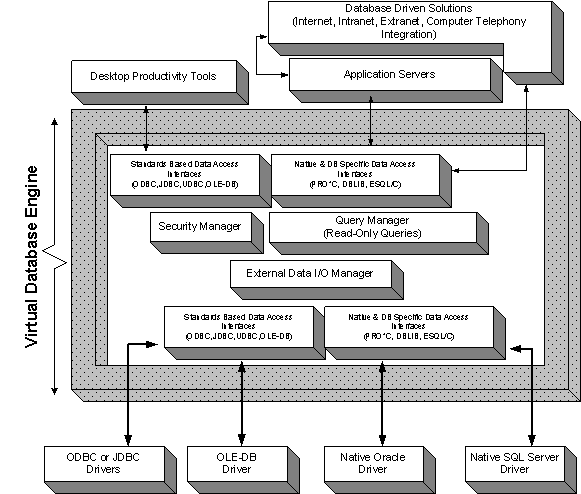
Type 10 VDB Engine
This category of VDB exposes its services via Open, Standards based, high-level data access interfaces. External data I/O is achieved by using either Open, Standards based, and Database Independent low-level data access interfaces or Native, Proprietary, and Database Specific low-level data access interfaces. This category of VDB possesses a complete set of traditional database engine components.
Figure 8.12. Type 10 VDB Architecture
